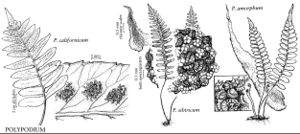Polypodium amorphum
Werdenda 1: 16. 1927.
Stems often whitish pruinose, slender, to 6 mm diam., acrid-tasting; scales weakly bicolored, lanceolate, contorted distally, bases and margins light-brown, sometimes with dark central stripe, margins often coarsely dentate. Leaves to 30 cm. Petiole slender, to 1.5 mm diam. Blade oblong to rarely deltate, pinnatifid, usually widest near middle, occasionally at or near base, to 4 cm wide, somewhat leathery; rachis sparsely scaly to glabrescent abaxially, glabrous adaxially; scales lanceolate-ovate, usually more than 6 cells wide. Segments oblong, less than 12 mm wide; margins entire to crenulate; apex rounded to broadly acute; midrib glabrous adaxially. Venation free. Sori midway between margin and midrib to nearly marginal, less than 3 mm diam., circular when immature. Sporangiasters present, usually less than 40 per sorus, heads covered with glandular-hairs. Spores more than 58 µm, rugose to verrucose, surface projections less than 3 µm tall. 2n = 74.
Phenology: Sporulating summer–fall.
Habitat: Cliffs and rocky slopes, usually on igneous substrates
Elevation: 0–1800 m
Distribution

B.C., Oreg., Wash.
Discussion
The diploid Polypodium amorphum is one of the progenitors of allotetraploid P. hesperium, and these two species are occasionally sympatric. Although P. amorphum can be mistaken for P. hesperium, consistent differences exist for separating these two species (see comments under P. hesperium). Hybridization between P. amorphum and P. hesperium results in triploid individuals with misshapen spores (F. A. Lang 1971).
Selected References
None.
Lower Taxa
"widest" is not a number.
